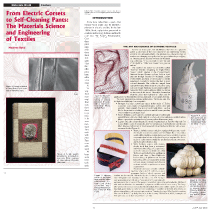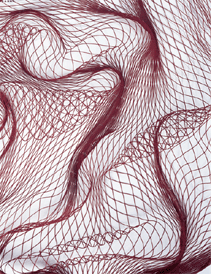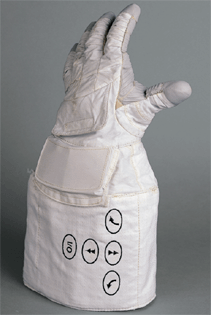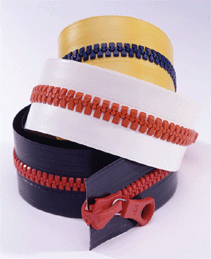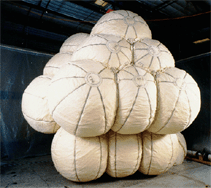 LATEST ISSUE |
||||
TMS QUICK LINKS: |
• TECHNICAL QUESTIONS • NEWS ROOM • ABOUT TMS • SITE MAP • CONTACT US |
JOM QUICK LINKS: |
• COVER GALLERY • CLASSIFIED ADS • SUBJECT INDEXES • AUTHORS KIT • ADVERTISE |
|
| Materials World: Feature | Vol. 57, No. 7, pp. 14-18 |
From Electric Corsets
to Self-Cleaning Pants:
The Materials Science and Engineering of Textiles
MAUREEN BYKO
| ||||
| ||||
| ||||
| ||||
| ||||
| ||||
| ||||
| ||||
| ||||
| ||||
| ||||
| ||||
| ||||
|
Questions? Contact jom@tms.org. © 2005 The Minerals, Metals & Materials Society |
INTRODUCTION Some have called him a quack. But George Scott might also be labeled a pioneer in electric textiles. In the late 1800s, Scott, a physician, purported to combine technology, fashion, and health care into “Dr. Scott’s Electropathic Corsets and Belts.” The purpose of these high-tech undergarments was “to promote the circulation, to stimulate the organic action, to renew vital energy, and assist digestion,” according to an advertisement preserved in the archives of the Smithsonian Institution in Washington, D.C. The ad does not explain how the garments work. It does claim, however, “Scientists are daily making known to the world the indisputably beneficial effects of Electro-Magnetism, when properly and scientifically applied to the human body in this manner; and it is also affirmed by professional men that there is hardly a disease which electricity and magnetism will not benefit or cure. . .”
All this and a waspish waist, too. Today, Scott’s corsets have gone the way of his electric hairbrushes, electric flesh brushes, and other technological marvels. But if he were alive today, Scott might feel vindicated to know that textile R&D has advanced in diverse directions, including combinations of electrical devices and clothing. Indeed, electronic devices are being woven into clothing to provide health benefits such as continuous heart-rate monitoring. Progress is being reported on conductive fibers woven into clothing to transmit information or create wearable antennas, ensuring lightweight, reliable communication for soldiers in the field. Materials science and technology is also being combined with clothing in ways that do not require electricity but are dramatic nonetheless. For example, fibers are being changed on a nano-level to provide benefits such as self-cleaning trousers or odor-resistant socks.
No one is promising the array of benefits Scott proposed so long ago, but in the next few years, researchers and textile scientists could introduce high-tech textiles to make life simpler, safer, and perhaps a bit more fun. INNOVATING TO SAVE AN INDUSTRY The primary function of clothing has always been fairly simple, said Yasser Gowayed, director of the National Textile Center at Auburn University in Texas: providing protection and comfort. Once those challenges are well under control, Gowayed said, the question arises: “Can I use it further?” And today, the answer is yes. Changes are occurring at the most basic level of textile manufacturing: in the fibers that are wound into yarns that are woven into fabrics that are dyed and made into clothing. “The focus is now on new developments in fiber, fiber style, fiber components—elements that can give added benefit to the user,” Gowayed said. Many of these developments are coming from the United States in an effort to revive a floundering textile industry, Gowayed believes. “The U.S. is losing its grip on traditional textile manufacturing,” he said. The National Textile Center is a consortium of eight universities that support research to improve the U.S. fiber/textile industries. Gowayed attributed the decline in U.S. textile manufacturing to free trade agreements that allow clothing to be produced more cheaply outside the United States and then imported. The U.S. manufacturers cannot compete in ordinary fabric production, Gowayed said. So they must reach for the extraordinary. “By creating new niche markets, they can still maintain superiority,” he said of the U.S. textile industry. Karl Spilhaus, president of the National Textile Association, a trade association for U.S. textile manufacturers, agreed that only by adding unique, desirable properties to fabrics will the U.S. industry survive. “That’s what manufacturers in this country can do,” Spilhaus said. “They certainly can’t compete on commodity fabric, but they ought to be able to compete on these higher-value-added goods.” The competition for new textile markets has clothing manufacturers working harder than ever to find their niche, and consumers are beginning to benefit. “There’s a lot of interesting, innovative things going on,” Spilhaus said. ADD A LITTLE NANO TO YOUR PANTS Philip J. Brown, a textile chemist at Clemson University in South Carolina, remembers some niche markets that did not last. Scratch-and-sniff clothing is one example. Pleasantly scented, tiny polymer beads were added to clothing, such as within a strawberry appliqué on a shirt. “If you saw a girl wearing a top with a strawberry on it, you could scratch it and you would smell strawberry,” Brown said. Those clothes were a fad in his home country of England at one time. Then there were menthol pajamas, scented to open the nasal passages of people suffering from colds, ensuring a good night’s sleep. “I didn’t see that go too big in the market,” he said. Nano-Tex Inside
The Nano-Tex process alters fibers to improve them, while at Clemson, Brown is hoping to create care-free fabrics with a coating instead. Brown said the work of his research group focused on the lotus. That plant, which lives in muddy environments, always has clean leaves because the leaves are covered with microscopic bumps that prevent water or dirt from sticking to the surface, he said. Using silver nanoparticles, Brown’s group added “bumps” to common fibers and achieved a lotus-like repellent effect. Water and dirt, instead of sticking to the fibers, easily run off. And, as a bonus, silver is antibacterial, Brown said, so the treated fibers are odor-resistant, too. Interest has been high since the work was discussed at the November 2004 meeting of the American Chemical Society. That’s to be expected, Brown said, based on the seemingly universal need for low-maintenance clothes. “Consumers appreciate comfort, fashion, looks, and wearability, and all those things that make it easy to look after,” he said. “Self-cleaning falls into that—you may have to wash it, but not as often.” If he had a finished product, Brown has no doubt people would buy it. But, unlike the Nano-Tex products, commercial marketing of the coating is probably years away. “We’re still investigating the properties of the material we’re making,” he said. NanoHorizons: Finding
New Value in Silver and Gold
“In my mind it’s actually easier to incorporate into the polymer itself in terms of streamlined production flow, but they both have their advantages,” Hayes said. For instance, if a company wanted to alter the optical properties of a material, the nanomaterials would probably best be incorporated into the fiber itself, Hayes said. Regardless of the intended effect, it does not take many of the nanoparticles to have an impact. “Depending on what specific properties you’re trying to get out of a material you’re adding, you can generally get a massive advantage using a nanoscale material in terms of efficacy,” he said. “When you take materials to the nanoscale you get a lot of interesting properties to them,” Hayes said. In April, NanoHorizons announced a joint venture with ARC Outdoors/ArcticShield, an outdoor clothing manufacturer. Among the interests of ARC Outdoors/ArcticShield are warmth, water proofing, odor control, moisture permeability, and comfort. Hayes did not want to discuss specifics of that venture, but said commercial products would be forthcoming. NanoHorizons is currently selling its gold and silver nanoparticles in bulk, but the group is studying other materials, too, to see what benefits they could provide. “We’re looking at all sorts of metal additives and polymer additives, inorganic, organic—we’re addressing most of the issues we can think of for the textile industry,” Hayes said. He predicted that the incorporation of nanotechnology into clothing manufacturing would mark the beginning of a significant shift in the textile industry that is long overdue. “In the U.S., I think the textile market has traditionally been underserved by technology, certainly nanotechnology,” Hayes said. “People are beginning to see that we can make an impact on textile companies.” POWER UP YOUR WARDROBE: e-TEXTILES For another sign of things to come in the world of textiles, one needs to look no further than Maggie Orth’s fuzzy pom-pom light switch (Figure 2)— just squeeze the tufts of conductive yarn and the lights come on. Or Sean Clearkin’s conductive jacket—press on a keypad on the sleeve, and the wearer can control an MP3 player without ever touching it (Figure 3). The technology, called electronic textiles or e-textiles, is in its infancy, but Orth expects it to eventually expand the role of clothing in everyday life.
“I think there will be very specific applications for electronic textiles,” she said. Orth, chief executive officer of International Fashion Machines in Seattle, Washington, ought to know: she is considered to be a pioneer in the field of electronic textiles, which behave as an electronic circuit or device. One of her original e-textile ventures was called a Firefly dress (Figure 4), which she helped design while she was working toward her Ph.D. in media arts and sciences at the Massachusetts Institute of Technology. The skirt of that dress was made of two layers of conductive organza, one acting as power and other as ground plane. Small light-emitting diodes (LEDs) were attached randomly to the skirt, with Velcro brushes on their ends. When both ends of the LEDs brushed against the power and ground planes, such as when the person wearing the dress walked, the circuit was complete and the dress lit up. It was stunning, but hand-made and not particularly practical. Orth has since developed what she calls Electric Plaid—plaid fabrics of thermochromic colors that change when heated (Figure 5). Those fabrics are now sold as decorator items, but since they need a heat source, they are not suitable for use in clothing, Orth said. The pom-poms, available for sale on Orth’s web site and, later this year, in boutiques, are Orth’s first attempt to commercialize e-textiles. The conductive yarns use capacitive sensing technology. Pressing on the yarn completes the circuit needed to turn on the lights. More work needs to be done to find mainstream adaptations of the technology, but Orth expects it to cross over to e-clothing eventually. “I think the big win for e-textiles is going to a color-changing textile—an electrochromic textile that changes color under electronic control, whether it’s bi-state or fully addressable,” she said. Such clothing would be fun to wear and could be functional, as well. “You’ll have ways to get information out, and you’ll have a display mechanism. My work is beginning to show what that would look like,” she said. For example, a backpack might have a patch that shows if snow is falling in the mountains, or running shoes could have displays of the wearer’s speed. Only one true example of e-textile clothing is available to consumers now, Orth said: a jacket made by Burton Snowboards. The jacket, marketed for several years to snowboarders, is made of conductive fabric that enables the control of an MP3 player by pressing a keypad on the sleeve. “Our technology involves a synergistic combination of conductive yarns, fabrics, and polymers that together provide the functionality of switching and pressure sensing,” said Sean Clearkin, chief executive of Softswitch Ltd., the U.K.-based company that developed the product. The fabrics are designed to carry signals, such as to control an Apple iPod, when pressed, while maintaining their comfort and flexibility. “The conductive yarns, principally metal-coated nylons and conductive fabrics form part of the overall system for carrying the signal,” he said. The Softswitch e-textiles will soon be available in a similarly equipped business suit, Clearkin said, for when the snowboarders move off the slopes and into the office. “They are taking an everyday fashion or clothing garment into a new realm of functionality—it is not just another suit but a convergence of fashion and the latest consumer electronics,” he said.
Orth noted that, aside from the Softswitch products, numerous items are making their way to the market that unite electronic devices and textiles. Because the textiles are not actually the devices, these do not qualify, technically, as e-textiles. “There’s tons of activities putting electronics into clothing,” Orth said. “It ranges from putting in an existing consumer device, to heating, to trying to cool clothing, to trying to get simple forms of information into clothing. There’s lots and lots of interest in body monitoring for health reasons (Figure 6), and just for fashion and fun reasons just to let things change color or give you more information. There’s a broad range of activity in the area.” CONCLUSION Could the researchers be too good? What would become of textile profits if they create fabrics so invincible that clothes never wear out? Sidney Stratton got a taste of the consequences of too much progress in the 1951 movie, The Man in the White Suit. In that satire, Alec Guinness as Stratton invents a wonder fabric—indestructible and impervious to dirt. Good news for consumers, but bad for the employees at the textile factory where Stratton works. His genius goes unappreciated and Stratton is chased down by a mob of angry textile workers and bosses. Fifty years later, the world seems to be teeming with Sidney Strattons looking for ways to create the perfect fabric. For example, Brown at Clemson hopes to see his self-cleaning fibers change the clothing market one day. Other researchers are looking for ways to make clothing more durable, even self-healing. Will the progress mark the end of clothing manufacturing as we know it? Brown has his doubts. “The reality is, if you use the right dye and the right finishes, clothes will last probably longer than you want the clothes for,” he said. “But from what I can tell from my wife, she needs new clothes all the time, so I don’t think wearing them out is a big issue.” Maureen Byko is managing editor of JOM.
|


